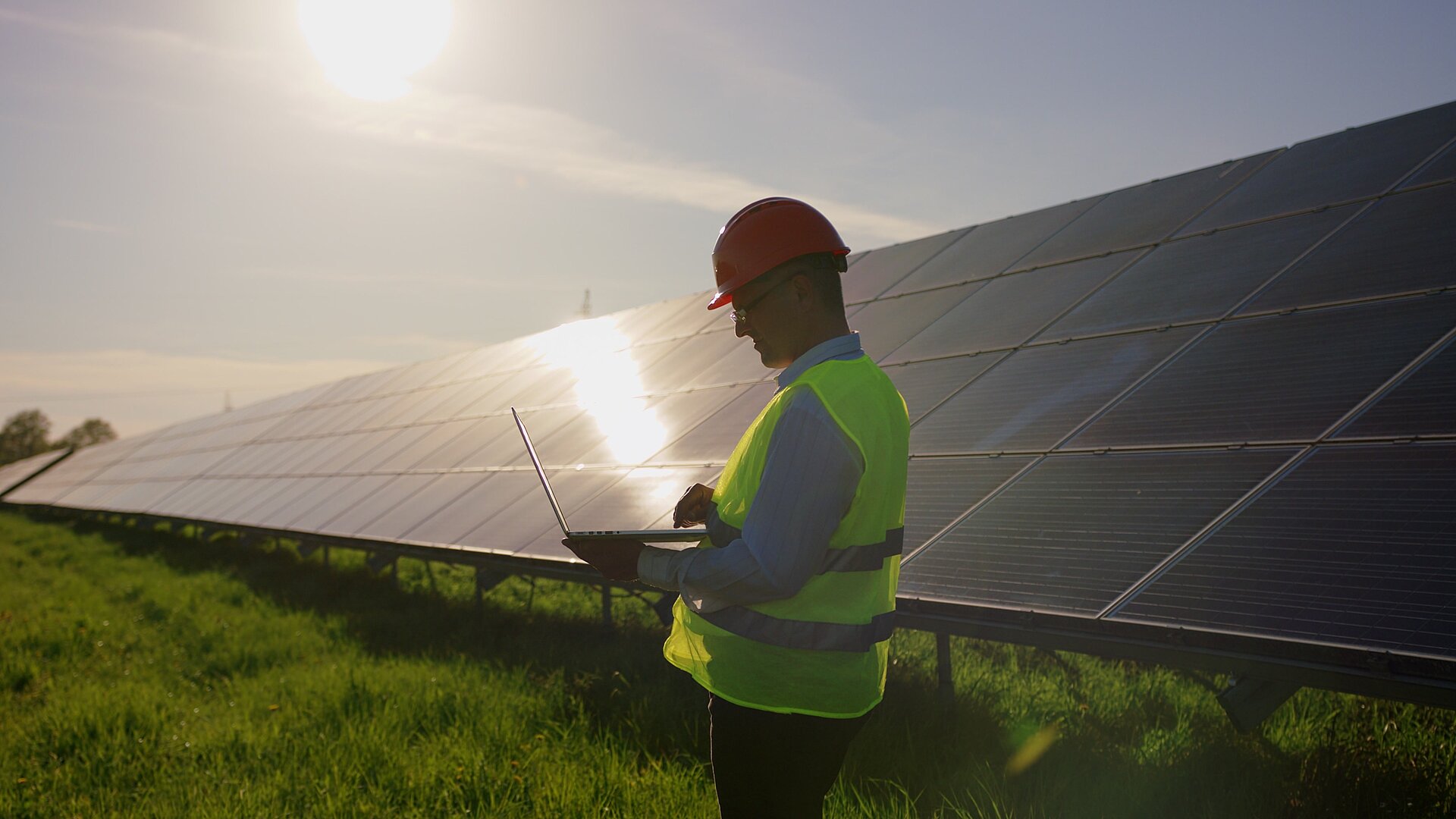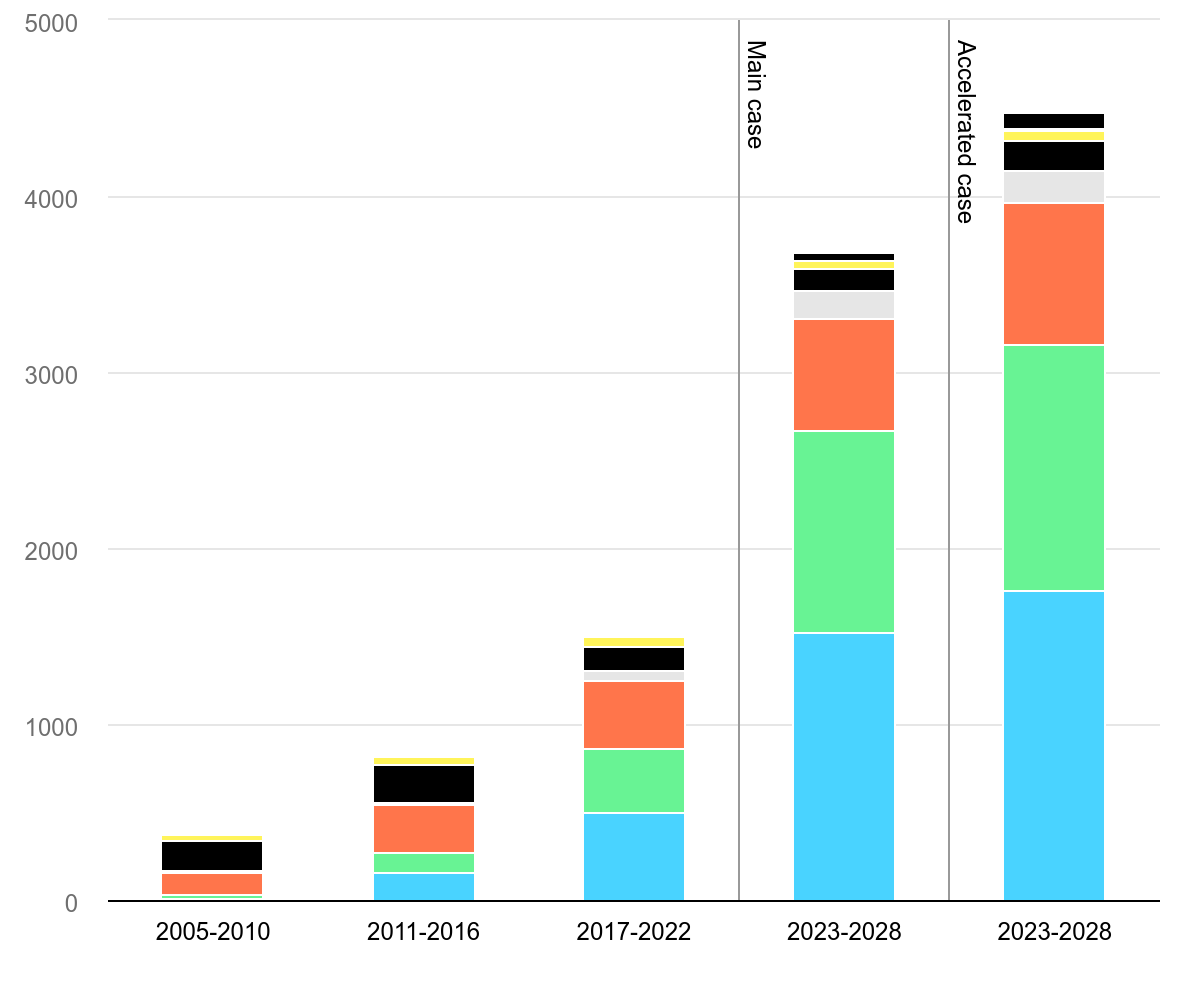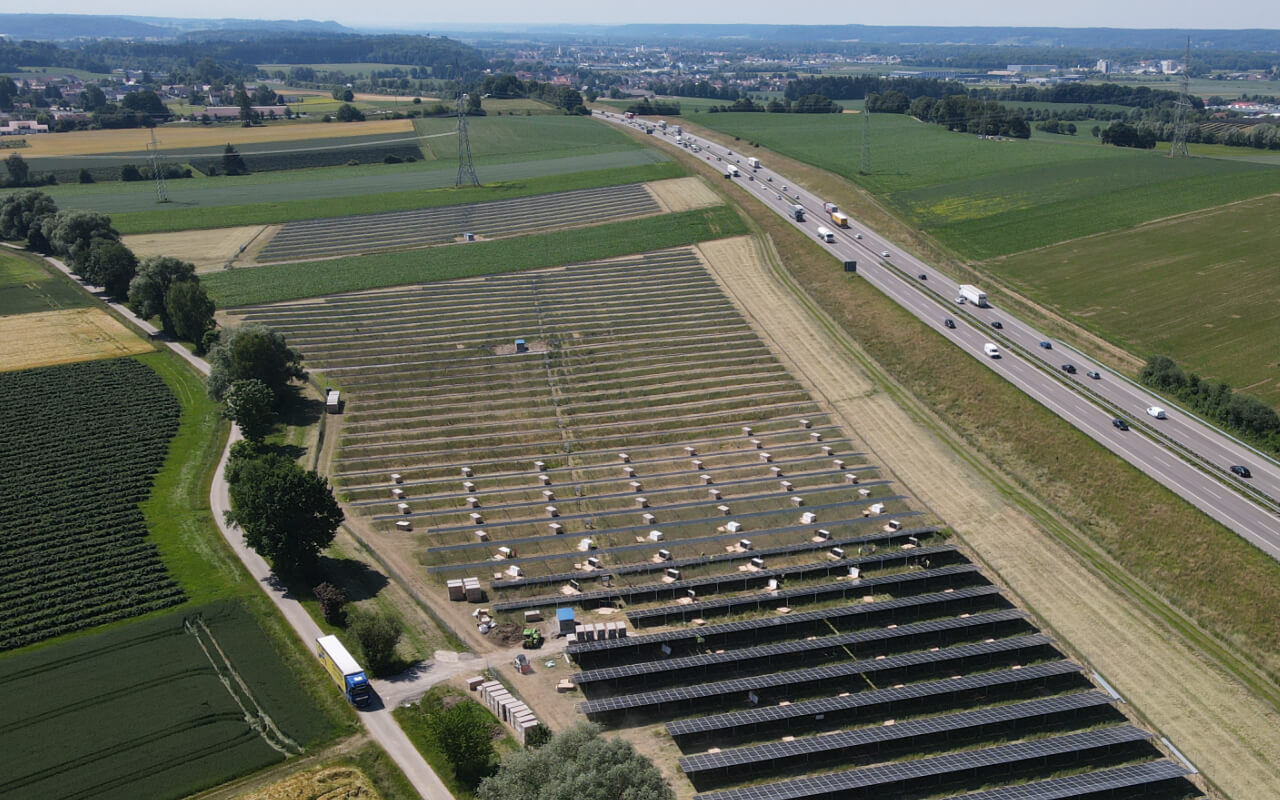Solar boom: How are the growth rates developing?

Just how impressive the global photovoltaic boom is can be seen from the records it has set: No other energy technology is receiving as much global investment as photovoltaics.1 Global photovoltaic installations have been growing exponentially for several years.2 At the beginning of 2023, a total of 1.4 terawatts (TW) of solar power had already been installed. The sound barrier of 2 terawatts was already broken in spring, which corresponds to an output of 2 billion kilowatts.3 The expansion of photovoltaics is also growing exponentially in Germany: a new European record of 15 GW was set in 2023. Last year's statutory expansion target of 88 gigawatts was already exceeded in the summer.4
In view of these figures, it is clear that photovoltaics is an exciting growth market for investment. But how will things continue? Can growth rates remain this high? Which segments are driving the solar market in Germany and around the world?
At the COP28 international climate protection conference in December 2023, political decision-makers committed to tripling global renewable energy capacity to at least 11 TW by 2030. In other words, they have set themselves the target of tripling the amount of renewable energy installed over the previous decades within six years. Is this target realistic? To what extent can the solar boom contribute to this?
Various renowned studies provide assessments of these questions.
What is driving the global solar boom?
One decisive factor for the recent growth is the drastic fall in the price of solar modules. While these still cost around 20 US dollars per watt in the 1980s, the price today is less than 0.30 US dollars per watt. This decline is due to technological advances, economies of scale and overcapacity in production.
Production capacity tripled in 2021 alone. In China in particular, huge production capacities have been built up in recent years, which are now estimated to be around one terawatt per year.5 However, demand has risen more slowly than production capacities have grown, which has contributed to falling prices. In 2023 alone, spot prices for solar modules have almost halved compared to the previous year.
However, the global energy crisis of 2022 further boosted demand in many regions, as governments, companies and consumers increasingly turned to solar energy as a cost-effective and reliable alternative. In addition, the electrification of the heating and transportation sectors accelerated. Numerous orders from 2021 and 2022 were also implemented in 2023. Many of the planned projects could be realized at lower prices as modules and installation companies were available again.6
What growth rates are realistic in the solar market?
The global growth rates of the photovoltaic market are impressive and are expected to remain stable at 10-20% per year in the coming years. According to reports by the International Energy Agency (IEA) and the European Solar Association, installed global solar capacity will increase from the current 1.6 terawatts (TW) to between 4 and 5 TW by 2028.7

IEA (2024), Renewable capacity growth by technology, main and accelerated cases, light blue is utility, green is rooftop, 2005-2028, @IEA, Paris CC BY 4.0
After exceptionally rapid growth in 2023, driven by post-pandemic product availability and the energy crisis, photovoltaics grew by 496 gigawatts of installed capacity in 2024, with Wood Mackenzie analysts forecasting similar growth in 2025.8 Production capacity will continue to grow, but not to the exceptional extent of the last two years. Module prices are also unlikely to fall as sharply as they did during 2023. Nevertheless, demand is forecast to grow significantly over the next four years as further cost improvements and the continued availability of components make solar energy increasingly attractive. The climate crisis and energy security issues will continue to be important drivers.
While the expansion of solar and wind energy is expected to increase significantly worldwide by 2028, the scenarios differ depending on political and economic developments. Slower growth rates could be caused by unresolved trade disputes, high interest rates and delays in political measures and infrastructure expansion. China in particular, the main growth driver, could be forced to slow down the expansion of domestic photovoltaics due to grid bottlenecks. However, faster growth is possible if lessons are learned from the energy crisis, politicians and markets react flexibly and the necessary infrastructure is provided quickly.
In order to exploit the full potential of solar energy, obstacles such as insufficient expansion of electricity grids, a lack of flexibility incentives, investment barriers and lengthy approval procedures must be removed.
In Germany too, the trend line shows that the expansion of solar energy needs to be further accelerated. Annual net additions are set to rise to 22 gigawatt peak (GWp) by 2026 in order to achieve the national target of 215 GW by 2030.9 10
Which market segments are growing the fastest?
In Germany, both ground-mounted and rooftop systems are experiencing dynamic growth, with rooftop systems currently dominating. The share of rooftop systems has been stable for years at around 70 % of total installed capacity, while there is considerable potential for expansion in the ground-mounted systems segment. A large proportion of ground-mounted systems are subsidized via EEG tenders, although unsubsidized projects are also becoming increasingly important.11
Rooftop systems are the main driver of photovoltaic expansion in Germany. 94% of the new PV capacity installed on buildings last year benefited from self-consumption advantages combined with feed-in tariffs. Smaller systems up to 25 kilowatts (kW) on residential, commercial or agricultural buildings in particular accounted for a significant proportion of the expansion. However, a downward trend was recorded in precisely this segment in the summer months.12 13
In the medium term, the aim is to equalize the shares of ground-mounted and rooftop systems so that both segments will each account for 50 % of installed capacity in the future. The tender in July 2024 was almost twice oversubscribed, which indicates a positive project pipeline.14 In the medium term, the replacement of older systems is also likely to gradually develop into a serious market segment.15
Global growth in photovoltaics is very unevenly distributed. In 2023, China accounted for 56 % of global installed capacity. However, more and more countries are developing into so-called “GW markets”, i.e. markets that install at least 1 GW of solar energy annually. While 28 countries still belonged to this group in 2022, by 2023 there were already 31, including 14 EU member states. The number of these GW markets is expected to rise to 50 by 2025.16
The ground-mounted segment will continue to grow strongly worldwide and will also account for more than half of the expansion figures in the coming years. The rooftop segment also has a promising future, although growth could level off slightly. In Europe, low energy prices could slow down growth in the rooftop segment.17
Is photovoltaics the game changer for climate protection?
All the studies and scenarios considered clearly show that the solar boom will continue. However, the crucial question for climate protection is whether the boom will be strong enough to achieve the necessary tripling of global renewable energy capacity to over 11 terawatts (TW) by 2030. The studies present optimistic scenarios, but point out that certain challenges must be overcome in order to realize this best-case scenario.
A report by the International Energy Agency (IEA) for 2023 identifies four key areas of action that are crucial to achieving this target and which vary from country to country and region to region: Policy uncertainties, insufficient investment in grid infrastructure, complex approval procedures and financing gaps in developing and emerging countries.18
Political uncertainties and delayed reactions to the new macroeconomic environment are making the expansion of renewable energies considerably more difficult. In developed countries in particular, rising costs and a lack of price indexation models have made many solar projects difficult to finance. According to BloombergNEF, around USD 1.8 trillion was invested in low-carbon technologies in 2023. To achieve net-zero targets, this sum would need to rise to an average of USD 5.4 trillion annually - a tripling of the current investment rate.19

@VenSol Neue Energien GmbH
Another obstacle is the insufficient investment in grid infrastructure. There are more than 3,000 gigawatts (GW) of renewable capacity in queues around the world, and many of these projects are already in advanced stages of development. However, the construction of new grids often takes five to 15 years, significantly longer than the development of renewable projects.20 It is therefore necessary to reduce the dependency on grid expansion, which can be achieved through flexibility markets, the overbuilding of grid connection points and hybrid power plants.
In addition, cumbersome approval procedures are hampering progress. It can take up to five years to obtain permits for ground-mounted PV systems. Simplifying these procedures, clear timeframes for approvals and priority areas for renewable projects could speed up the processes considerably.
A large part of the necessary tripling can be achieved within the G20 countries if existing expansion targets and the necessary legislative measures are consistently implemented. Analysts assume that President Trump will continue to pursue similar policies in the USA in the area of photovoltaics.21 Financing mechanisms and tax benefits may be weakened.22 At the same time, emerging and developing countries outside the G20, which have no clear targets or support measures to date, must also be won over to the global energy transition.
Conclusion
As outstanding as the growth rates of the solar boom sound, it will take a long time to slow down the global rise in temperature, which is dangerous for life on earth. We should not be discouraged by the primary energy figures, according to which solar energy contributed only 5.5 % to global electricity production in 2023.23 This is because while around 70 % of primary energy from fossil fuels is lost as waste heat and 30 % can be used as electricity, renewable energies supply 100 % usable electricity. In addition, the efficiency of electrically powered vehicles is three times higher than that of combustion engines.24 The optimistic scenarios show that the photovoltaic boom has brought the achievement of renewable expansion targets within reach.
Photovoltaics is therefore a crucial element in climate protection and offers good reason for hope. It is the most important energy source of the future. Wind energy is in second place among the necessary renewable energy sources. In addition, the achievement of energy efficiency targets is of paramount importance, with electrification playing a significant role in transport and heat supply.
1 Global annual investment in solar PV and other generation technologies, 2021-2024 (IEA 2024)
2 The exponential growth of solar power will change the world (The Economist 2024)
3 DIW Wochenbericht: Solarenergie in Deutschland boomt (DIW 2024)
4 Ausbau der Solarenergie: viel Licht, aber auch Schatten (DIW 2024)
5 DIW Wochenbericht: Solarenergie in Deutschland boomt (DIW 2024)
6 Global Market Outlook for Solar Power 2024–2028 (Solar Power Europe, 2024)
7 Global Market Outlook for Solar Power 2024–2028 (Solar Power Europe, 2024)
8 Wood Mackenzie prognostiziert für 2025 eine Stagnation des Photovoltaik-Wachstums (pv magazine)
9 Aktuelle Fakten zur Photovoltaik in Deutschland (Fraunhofer ISE, 2024)
10 DIW Wochenbericht: Solarenergie in Deutschland boomt (DIW 2024)
12 Zubau bei Photovoltaikanlagen unter 30 Kilowatt geht deutlich zurück (pv magazine)
13 The smarter E schließt mit Rekordzahlen, aber auch skeptischem Blick in die Zukunft (pv magazine)
14 Ergebnisse der Ausschreibung für PV-Freiflächenanlagen (Fachagentur Wind und Solar 2024)
15 Aktuelle Fakten zur Photovoltaik in Deutschland (Fraunhofer ISE, 2024)
16 Global Market Outlook for Solar Power 2024–2028 (Solar Power Europe, 2024)
17 Global Market Outlook for Solar Power 2024–2028 (Solar Power Europe, 2024)
19 New Energy Outlook 2024 (BloombergNEF)
21 Die Zukunft der Politik für erneuerbare Energie in einer neuen Trump-Regierung (pv magazine)
22 Welchen Stellenwert die Photovoltaik in der Energiepolitik von Donald Trump hat (pv magazine)
23 Global Market Outlook for Solar Power 2024–2028 (Solar Power Europe, 2024)
24 LinkedIn Post des Energieexperten Stefan Meyer zu Primärenergie-Irrtum